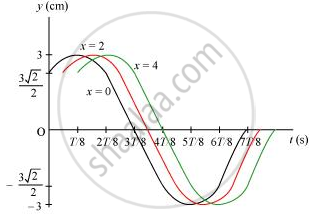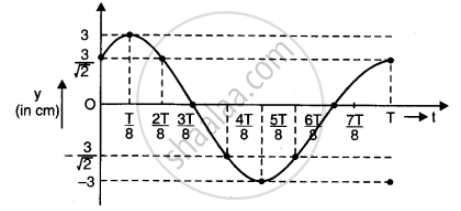Advertisements
Advertisements
Question
For the wave described in Exercise 15.8, plot the displacement (y) versus (t) graphs for x = 0, 2 and 4 cm. What are the shapes of these graphs? In which aspects does the oscillatory motion in travelling wave differ from one point to another: amplitude, frequency or phase?
Solution 1
All the waves have different phases.
The given transverse harmonic wave is:
`y (x,t)= 3.0 sin (36t + 0.018x + pi/4)` ...(i)
For x = 0, the equation reduces to:
`y (0,t) = 3.0 sin (36t + pi/4)`
Also, `omega = (2pi)/T = 36 " rad/s"^(-1)`
`:. T = pi/8 s`
Now, plotting y vs. t graphs using the different values of t, as listed in the given table.
| t(s) | 0 | T/8 | 2T/8 | 3T/8 | 4T/8 | 5T/8 | 6T/8 | 7T/8 |
| y(cm) | `(3sqrt2)/2` | 3 | `(3sqrt2)/2` | 0 | `(-3sqrt2)/2` | -3 | `(-3sqrt2)/2` | 0 |
For x = 0, x = 2, and x = 4, the phases of the three waves will get changed. This is because amplitude and frequency are invariant for any change in x. The y-t plots of the three waves are shown in the given figure.

Solution 2
The transverse harmonic wave is
`y(x,t) = 3.0 sin (36t + 0.018x + pi/4)`
for x = 0
`y(0,t) = 3 sin(36t + 0 + pi/4) = 3 sin (36t + pi/4)` ...1
Here `omega = (2pi)/T = 36 => T =(2pi)/36`
To plot a(y) versus (t) graph, different values of y corresponding to the values of t may be tabulated as under (by making use of equation 1)
| t(s) | 0 | T/8 | 2T/8 | 3T/8 | 4T/8 | 5T/8 | 6T/8 | 7T/8 | T |
| y(cm) | `(3sqrt2)/2` | 3 | `(3sqrt2)/2` | 0 | `(-3sqrt2)/2` | -3 | `(-3sqrt2)/2` | 0 | `3/sqrt2` |
Using the values of t and y (as in the table), a graph is plotted as under The graph obtained is sinusoidal.
Similar graphs are obtained for y x = 2 cm and x = 4 cm. The (incm) oscillatory motion in the travelling wave only differs in respect of phase. Amplitude and frequency of oscillatory motion remains the same in all the cases.

APPEARS IN
RELATED QUESTIONS
A metre-long tube open at one end, with a movable piston at the other end, shows resonance with a fixed frequency source (a tuning fork of frequency 340 Hz) when the tube length is 25.5 cm or 79.3 cm. Estimate the speed of sound in air at the temperature of the experiment. The edge effects may be neglected.
A sine wave is travelling in a medium. The minimum distance between the two particles, always having same speed, is
Two wires A and B, having identical geometrical construction, are stretched from their natural length by small but equal amount. The Young modules of the wires are YA and YB whereas the densities are \[\rho_A \text{ and } \rho_B\]. It is given that YA > YB and \[\rho_A > \rho_B\]. A transverse signal started at one end takes a time t1 to reach the other end for A and t2 for B.
The equation of a wave travelling on a string is \[y = \left( 0 \cdot 10 \text{ mm } \right) \sin\left[ \left( 31 \cdot 4 m^{- 1} \right)x + \left( 314 s^{- 1} \right)t \right]\]
(a) In which direction does the wave travel? (b) Find the wave speed, the wavelength and the frequency of the wave. (c) What is the maximum displacement and the maximum speed of a portion of the string?
Two long strings A and B, each having linear mass density
\[1 \cdot 2 \times {10}^{- 2} kg m^{- 1}\] , are stretched by different tensions 4⋅8 N and 7⋅5 N respectively and are kept parallel to each other with their left ends at x = 0. Wave pulses are produced on the strings at the left ends at t = 0 on string A and at t = 20 ms on string B. When and where will the pulse on B overtake that on A?
A 200 Hz wave with amplitude 1 mm travels on a long string of linear mass density 6 g m−1 kept under a tension of 60 N. (a) Find the average power transmitted across a given point on the string. (b) Find the total energy associated with the wave in a 2⋅0 m long portion of the string.
What is the interference of sound waves?
Use the formula `v = sqrt((gamma P)/rho)` to explain why the speed of sound in air increases with temperature.
Given below are some functions of x and t to represent the displacement of an elastic wave.
- y = 5 cos (4x) sin (20t)
- y = 4 sin (5x – t/2) + 3 cos (5x – t/2)
- y = 10 cos [(252 – 250) πt] cos [(252 + 250)πt]
- y = 100 cos (100πt + 0.5x)
State which of these represent
- a travelling wave along –x direction
- a stationary wave
- beats
- a travelling wave along +x direction.
Given reasons for your answers.
A wave of frequency υ = 1000 Hz, propagates at a velocity v = 700 m/sec along x-axis. Phase difference at a given point x during a time interval M = 0.5 × 10-3 sec is ______.
